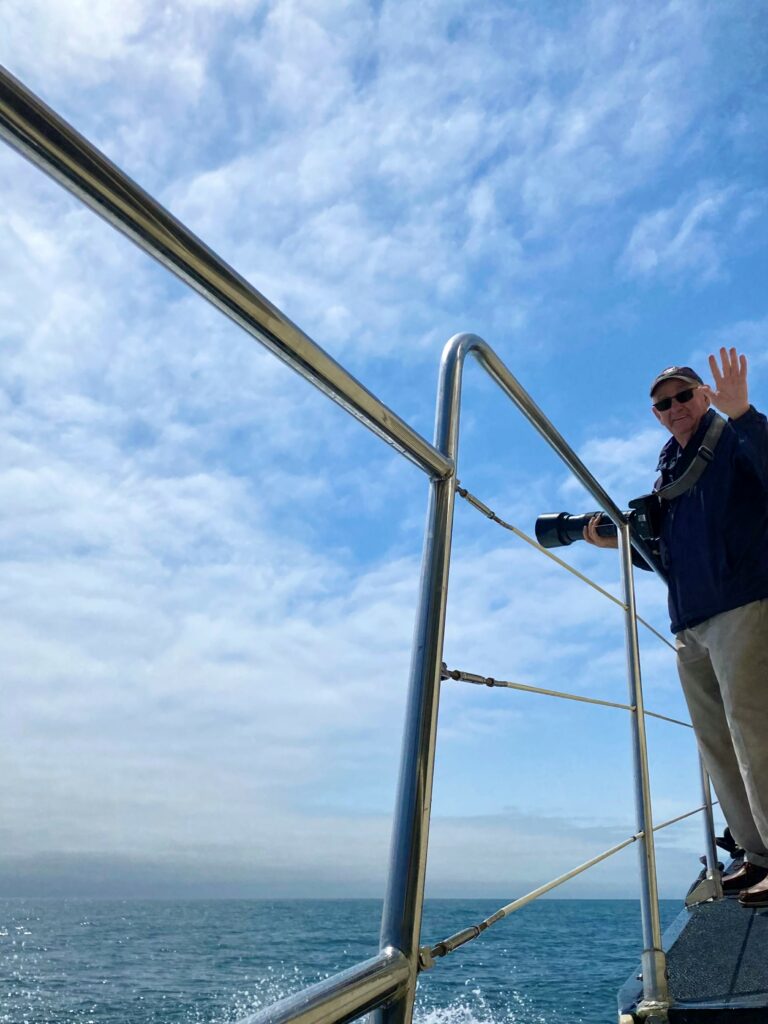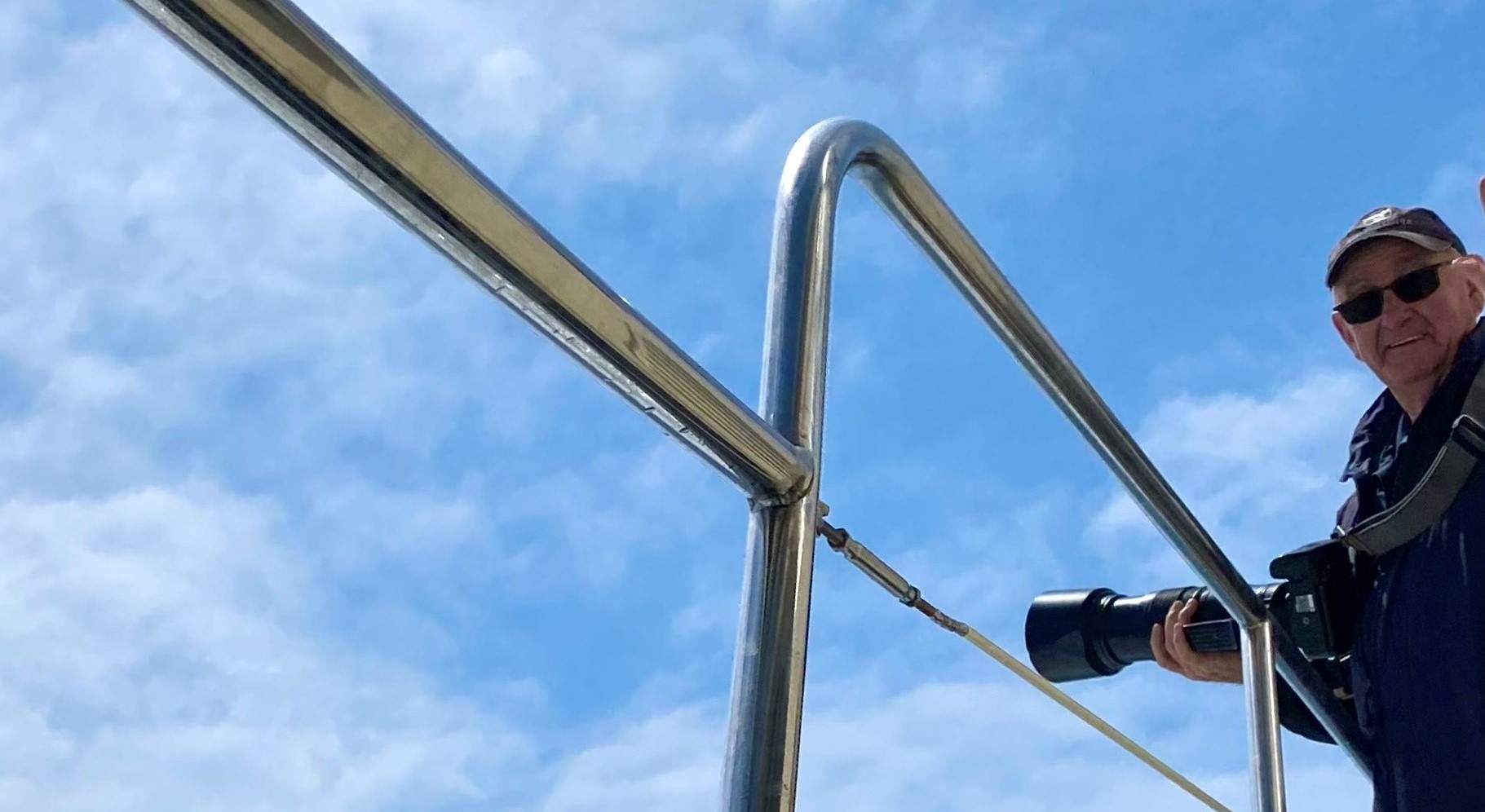Watching whales in the wild is a wonder in itself, but for many passengers their adventure is not complete without the perfect picture.
As many of you would be aware photographing wild animals comes hand in hand with many challenges. Unlike the whales and dolphins at Sea World, animals in the wild don’t breech on cue, not to mention the fact that they constantly move around. Coupled with being aboard a moving vessel, it can be difficult to capture a perfect shot.
The good new is, we have seen hundreds of absolutely beautiful photographs from our tours over the years. And, with the right gear and a bit of know how, you too can capture amazing photos of Vancouver Island’s world-class marine wildlife. Here are a few tips for capturing the perfect whale-watching photo to get you started.
Preparation
It sounds basic, but preparing for your trip includes more than just choosing which lens you are attaching to your camera. The last thing you want to be doing when trying to take a photo is worrying about being cold, getting sunburnt or feeling unwell – so ensure you are prepared for your trip before you depart.
Regardless of the weather, always bring a jacket, as it can get quite cold out on the open water. It is also important to protect yourself from the sun, bring a hat, sunglasses and sunblock. If you are affected by motion sickness, listen to the advice provided by the crew regarding the weather conditions and wear a travel band or visit the pharmacist before your trip.
If you are travelling on a Zodiac, be sure to have a neck strap attached to your camera, as it is the best place to store it (while travelling) is around your neck, tucked in under your flotation suit, with the zip done up.
Believe it or not, one of the easiest things to forget is to fully charge your camera/battery and ensure you have enough memory on your memory card. Make sure you check this the night before and bring a spare camera battery if you have one.
The Right Gear for the Job
Before you arrive for your tour, sort out what camera equipment you are going to use. While cell phone and tablet technology has improved considerably in recent years, you will be best off using either a point-and-shoot camera or, preferably, a DSLR (digital single-lens reflex camera).
A DSLR is handy for taking whale-watching photos, as you can attach larger lenses, giving you greater control over your shot. When aboard our larger vessel, Marauder IV, there is no need to worry about your camera getting wet, so a waterproof case isn’t necessary. While most people are fine without one, you may want to bring a cover for your camera if you are travelling aboard a Zodiac (a shower cap or plastic bag will suffice) – just incase it’s a wet ride.
We don’t recommend bringing a mini tri-pod or stabilizer (especially aboard the Zodiacs) as they are impractical and offer little assistance aboard a moving vessel.
You don’t need a really expensive camera to take a great photo. However, if you saved money purchasing a lesser-priced camera, it is worth spending a bit of extra money on a flash or memory card that has a fast processing speed. If you are planning to take wildlife photos using a ‘burst’ function (where multiple images are taken very quickly) a card with a decent write speed is essential. The write speed determines how quickly the data is transferred onto the card after the photo is taken and makes all the difference when taking many photos in quick succession. A card’s specs will generally be noted on the packaging. However, if you’re unsure about which card to choose, just ask at any good photography shop or jump online (there’s plenty of information out there). Just remember, not all memory cards are created equal!
Which Lens to Use
If you are choosing between lenses and don’t want to be tied down with bags of equipment, we recommend a zoom lens (try a zoom 70-300 or 70-200). If you are using a film camera, try using a 400 speed film. The minimum distance for viewing whales in Canada is 100m (approx.100 yards) and 200m in the United States (approx. 200 yards), so you will most likely be taking photos from that distance. You may also get the opportunity to take a few wide-angle shots, in which case, you can bring an extra lens. Alternatively, consider bringing a compact point-and-shot along for those wider shots. It’s also a good idea to carry a dry lens rag in your pocket.
Getting Your Settings Right
If you are unfamiliar with your camera settings and/or you have a simple point-and-shoot camera, we suggest simply switching to the ‘sports’ or ‘action’ settings and turning your flash off.
If you’re used to adjusting the settings on your camera, here are a few tips to help you capture a great shot.
Higher ISO settings are generally used in darker situations to get faster shutter speeds. An ISO speed of at least 400 is recommended to obtain shutter speeds fast enough to freeze the action of travelling whales (especially, if the whales are breaching). If the light is poor or fading, you made need to increase the ISO even more (up to 1600 for evening tours).
To freeze movement in an image you’ll want to choose a faster shutter speed. The actual speed you should choose will vary depending upon the speed of the subject in your shot. When trying to freeze the action of a breaching whale, we generally recommend adjusting your shutter speed to 1000-1200.
When it comes to camera settings there is no perfect preset for whale watching – it will of course depend on a variety of factors including, the amount of light, direction of the sun, whether the whales are breeching and how far away they are. The best thing to do is to get to know your settings and keep adjusting them until you get a combination you’re happy with. The more photos you take, the more chance there is that you’ll get a good one.
Patience is Key
Murphy’s Law tells us that as soon as you look away or put your camera down the whales will do something amazing. Rule number one is always have your camera ready. Always keep your eyes on water scanning for whales (and other wildlife). If the whale you are trying to photograph has taken a dive, never fix your eyes on that one spot – it will most likely come up in a different location to where it went down. In these situations, patience is key – whales have to surface to breath, so keep your eyes peeled.
The Right Place at the Right Time
To improve your chances of getting that perfect photo you need to be in the right spot at the right time. This doesn’t just mean jumping on a boat in the peak of the whale-watching season. There are other things you can do to give yourself the best chance of capturing a great photo. The first is listening to the crew. The SpringTide crew are experienced whale watchers and work hard to predict whale behavior and travel direction. By listening to their directions you will give yourself the best possible chance of capturing a great shot. If you are travelling aboard the Marauder IV, it is also important to position yourself somewhere that you can easily grab a hold of something stable (a side or bench rail) encase you loose you balance while focusing on what you see through the lens.
Hopefully these quick tips will help you capture your experience with our amazing marine wildlife. If you have some photos that you’d like to share, we’d love it if you posted them on our Facebook page, Instagram or Twitter. Happy snapping!


